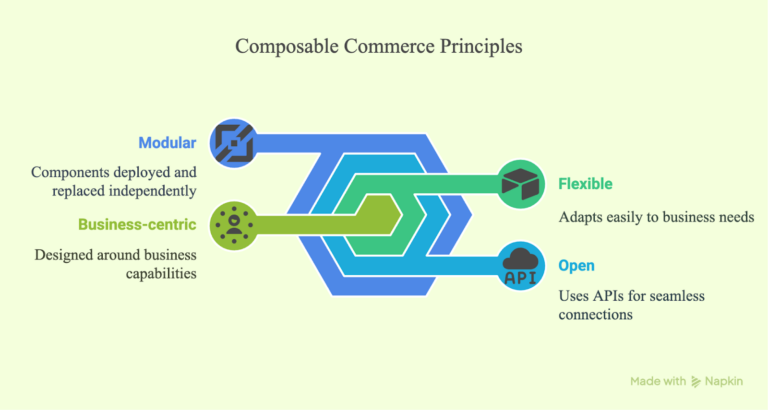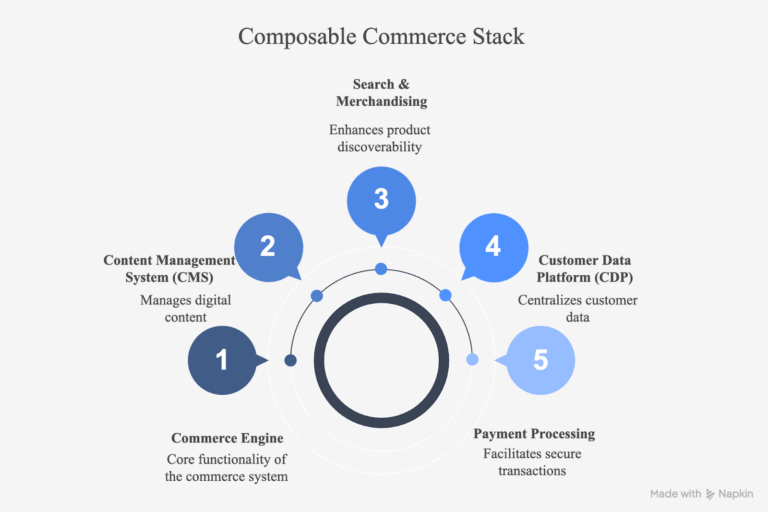Greetings! I'm Aneesh Sreedharan, CEO of 2Hats Logic Solutions. At 2Hats Logic Solutions, we are dedicated to providing technical expertise and resolving your concerns in the world of technology. Our blog page serves as a resource where we share insights and experiences, offering valuable perspectives on your queries.

Quick Summary
Composable commerce is a modern approach that lets eCommerce businesses build their stores using flexible, interchangeable components instead of relying on a single, rigid platform. Each part, like checkout, product management, or payments, works independently and connects through APIs. This makes it easier to customize, update, and scale your store without major overhauls. While it requires careful setup and some technical knowledge, it offers more freedom, faster innovation, and avoids being locked into one vendor, making it a great choice for growing businesses.
Have you ever found yourself constrained by your e-commerce platform’s limitations? You’re trying to implement a unique customer experience, but your current system just won’t accommodate your vision.
This is the reality for countless businesses trapped in monolithic commerce systems. Customization is a tedious task for the user. We all want better technology that can serve us well.
Composable commerce offers a powerful alternative. This is now reshaping how forward-thinking businesses approach their digital commerce architecture.
What is composable commerce?
Composable commerce is an architectural approach that enables businesses to select best-of-breed commerce components. You can combine them flexibly to create custom digital commerce experiences.
Unlike traditional all-in-one platforms, composable commerce follows the principle of “composability.” This helps you to select and assemble modular business capabilities to meet specific business requirements.
Think of it this way: traditional commerce platforms are like buying a pre-built house with fixed rooms and layouts. Composable commerce, in contrast, is like building with specialized Lego blocks; you select exactly what you need and arrange them according to your unique vision.
“Composable commerce gives businesses the freedom to differentiate through technology rather than being limited by it. It’s the difference between being a passenger and being in the driver’s seat.”
Dirk Hoerig, Founder & CEO of commercetools
The Four Key Principles of Composable Commerce
Gartner, who popularized the concept, outlines four essential principles:

- Modular: Components can be deployed and replaced independently
- Open: Uses APIs and integrations for seamless connections
- Flexible: Adapts easily to business needs through configuration
- Business-centric: Designed around business capabilities rather than technical constraints
This approach creates a commerce ecosystem that can evolve incrementally. This allows businesses to respond quickly to market changes without complete system overhauls.
Composable vs. Monolithic vs. Headless Commerce
To understand composable commerce more clearly, let’s compare it with other commerce architectures:
| Architecture | Description | Flexibility | Implementation Complexity | Best For |
| Monolithic | All-in-one solution with tightly coupled frontend and backend | Low | Lower | Small businesses with standard needs |
| Headless | Separated frontend and backend connected via APIs | Medium | Medium | Businesses focused on frontend flexibility |
| Composable | Modular components that can be mixed, matched, and replaced | High | Higher | Businesses needing full system flexibility |
While headless commerce separates the frontend from the backend, composable commerce takes modularity further by breaking down the backend itself into interchangeable components.
Pro Tip: When evaluating your commerce architecture needs, consider your growth trajectory. The flexibility that composable commerce offers becomes increasingly valuable as your business grows and your requirements become more complex.
The Building Blocks of Composable Commerce
A composable commerce stack typically includes these modular components:

1. Commerce Engine
The commerce engine is the core of a composable commerce stack, handling essential business logic. It manages product information, cart and checkout processes, order management, and pricing or promotions.
This component ensures smooth transactions and a smooth shopping experience by centralizing key commerce operations.
2. Content Management System (CMS)
A CMS allows businesses to create and manage digital content effortlessly. It supports product descriptions, blog posts, landing pages, and rich media like images and videos.
3. Search & Merchandising
This component enhances product discovery through intelligent search and personalized recommendations. It powers on-site search functionality, curated product listings, and category management.
This is helping customers find what they need quickly while enabling merchants to showcase relevant items effectively.
4. Customer Data Platform (CDP)
A CDP consolidates customer data into unified profiles. This offers deep insights into behavior and preferences. It tracks interactions, segments audiences, and provides analytics, allowing businesses to deliver personalized experiences and targeted marketing campaigns.
5. Payment Processing
Payment processing ensures secure and flexible financial transactions. It supports multiple payment methods, fraud detection, tax calculations, and subscription billing.
How Composable Commerce Benefits E-Commerce Businesses
Now, let’s explore the specific advantages composable commerce offers to forward-thinking e-commerce businesses.
Composable commerce is a modular approach to building ecommerce systems. This provides businesses with flexibility, scalability, and the ability to deliver personalized experiences. Here are six top benefits of adopting composable commerce for ecommerce businesses:
1. Flexibility and Agility
Businesses can select best-in-class solutions, avoiding reliance on monolithic platforms.
This modularity enables rapid adjustments to market trends or customer preferences, ensuring adaptability.
2. Enhanced Customer Experience
Composable commerce allows for highly personalized shopping experiences. This is done through advanced tools like recommendation engines and dynamic pricing strategies.
It ensures seamless omnichannel experiences across devices and platforms.
3. Scalability
Businesses can scale individual components during peak seasons or expand into new markets without overhauling the entire system.
4. Faster Time to Market
New features or products can be launched quickly by integrating standalone modules, reducing development cycles.
Backend changes can be implemented without disrupting the frontend experience.
5. Cost-Effectiveness
By choosing only necessary components, businesses save costs on unused features and reduce maintenance expenses.
Efficient resource allocation minimizes friction and unintended consequences.
6. Future-Proofing
Composable commerce supports innovation by enabling businesses to adopt new technologies and channels easily.
It ensures resilience and flexibility in responding to evolving consumer expectations and market demands.
Challenges and Considerations
Composable commerce isn’t without challenges. Be prepared to address:
1. Increased Technical Complexity
- Requires stronger technical capabilities
- More integration points to manage
- Need for API governance and standards
- Complex troubleshooting across components
2. Vendor Management Overhead
- Multiple vendor relationships to manage
- Different release cycles and roadmaps
- Varying support levels and processes
- Potential finger-pointing during issues
3. Initial Implementation Investment
- Higher upfront planning requirements
- More complex initial architecture design
- Potential need for specialized expertise
- Longer time-to-market for first release
The Future of Composable Commerce
As composable commerce continues to evolve, several trends are emerging:
1. AI-Powered Composition
Machine learning will increasingly guide the selection and configuration of commerce components based on business needs and performance data.
2. Low-Code Composition Tools
New tools will emerge that allow business users to compose experiences with less developer involvement.
3. Industry-Specific Component Ecosystems
Vertical-specific marketplaces of pre-integrated components will accelerate implementation for particular industries.
4. Composable Operations
The composable approach will extend beyond technology to business operations, with modular fulfillment, customer service, and marketing operations.
Conclusion
At 2HatsLogic, we specialize in guiding businesses through successful composable commerce implementations. Our team combines deep technical expertise with strategic business understanding to create flexible, future-proof commerce architectures that drive growth.
Whether you’re just beginning to explore composable commerce or ready to implement specific components, we can help you navigate the journey with confidence. Our proven methodology ensures smooth transitions, knowledge transfer to your team, and ongoing support to maximize your ROI.
Contact our experts today to discuss how composable commerce can transform your business.
FAQ
What is composable commerce?
Composable commerce is a modular approach where you build your e-commerce platform using specialized, interchangeable components rather than a single all-in-one solution.
How does it differ from traditional platforms?
Traditional platforms are rigid, all-in-one solutions, while composable commerce lets you select and replace individual components (payment, search, etc.) without disrupting your entire system.
What business benefits does it provide?
Composable commerce delivers greater business agility, reduced vendor dependency, and the ability to create differentiated customer experiences tailored to your unique business needs
Table of contents




